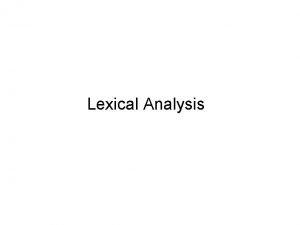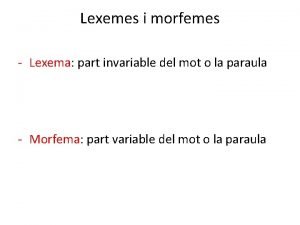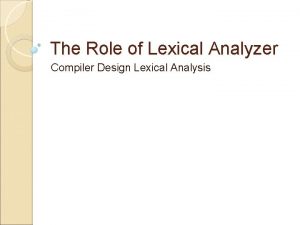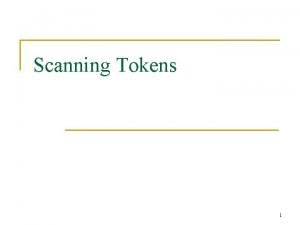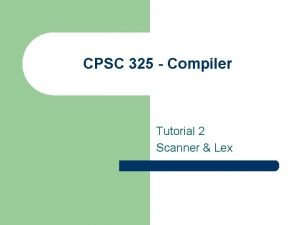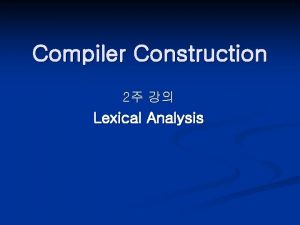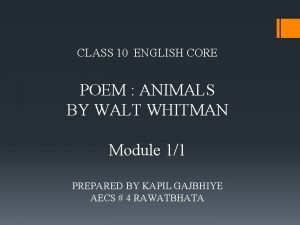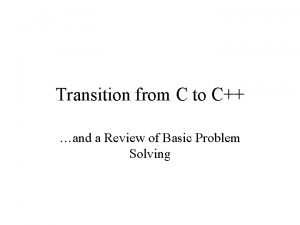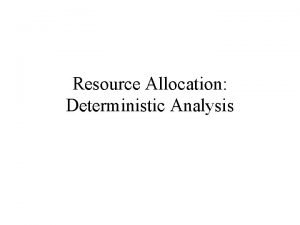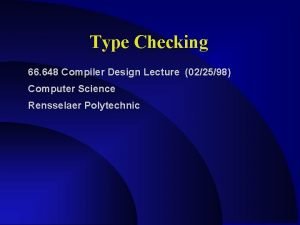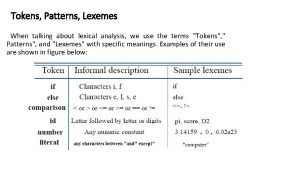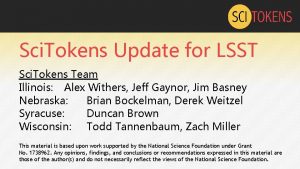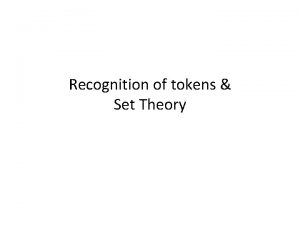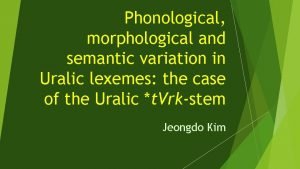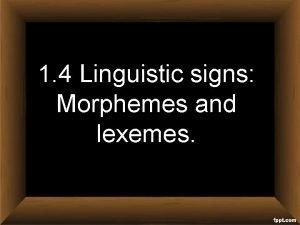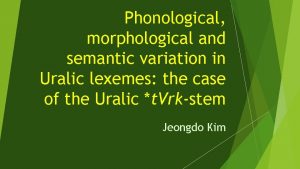Specification of Tokens l Lexemes are simple l






















- Slides: 22

Specification of Tokens l Lexemes are simple l Tokens are sets of lexemes. . l So: Tokens form a REGULAR LANGUAGE l Use REGULAR EXPRESSION to precisely describe what strings each type of token can recognize 1

Learn by Example: l Token to be specified = Identifier of C • letter → A | B | C | … | Z | a | b | … | z • digit → 0 | 1 | 2 | … | 9 • identifier → letter ( letter | digit )* 2

Another Example: l l l What are the patterns (Regular Expressions) for the following tokens? if → if then → then else → else relop → < | <= | >= | <>(not equal) 3

Token Recognition l l Tokens can be recognized using a Transition diagram Token to be specified >= Return (relop, GE) *Return (relop, GT) 4

Learn by Example l Relational Operators in Java l Specification of token relop → < | <= | >= | <> Recognition of token relop l • <= • >= • <> 5

Learn by Doing l Pattern for All Strings that start with “tab” or end with “bat” ? l Answer tab {A, …, Z, a, . . . , z}* | {A, …, Z, a, . . , z}*bat 6

7

Learn by Doing l Identifiers in Java l Specification of token identifier • position • Sal 123 • ab • x identifier → letter ( letter | digit )* l Recognition of token identifier ? 8

Learn by Doing 9

Terminologies : Automata & Language Theory l l l Finite State Automata (FSA) • A recognizer that takes an input string and determines whether it’s a valid string of the language. Non-Deterministic FSA (NFA) • Has several alternative actions for the same input symbol Deterministic FSA (DFA) • Has 1 action for any given input symbol 10

Representing NFA 1) Transition Diagrams : Number states (circles), arcs, final states, … l l l What language is defined? (a/b)*abb 11

Representing NFA 2) Transition Tables: More suitable to representation within a computer l 12

Learn by Example l Given the regular expression : (a (b*c)) | (a (b | c+)? ) l Find a transition diagram NFA that recognizes it 13

Learn by Example – NFA construction Step 1: (a (b*c)) | (a (b | c+)? ) (a (b*c)) 14

Learn by Example – NFA construction Step 2: (a (b*c)) | (a (b | c+)? ) 15

Learn by Example – NFA construction Step 3: (a (b*c)) | (a (b | c+)? ) 0 16

Working of NFA Learn by Example: OR Input: ababb 1. move(0, a) = 1 2. move(1, b) = 2 3. move(2, a) = ? (undefined) move(0, a) = 0 move(0, b) = 0 move(0, a) = 1 move(1, b) = 2 move(2, b) = 3 REJECT ! ACCEPT ! 17

The NFA Problem l l Two problems – Valid input may not be accepted – Non-deterministic behavior from run to run… Solution ? 18

The DFA Saves The Day l A DFA is an NFA with a few restrictions l No epsilon transitions. l For every state s, there is only one transition (s, x) from s for any symbol x in Σ 19

NFA-DFA comparison 20

How does this all fit together ? 3. Reg. Expr. → NFA construction NFA → DFA conversion DFA simulation for lexical analyzer l Point to Remember 1. 2. • Both NFA and DFA can be used to recognize tokens, but DFA are faster and more optimizable than NFA 21

l l l Tokens can be specified by using regular expressions Tokens can be recognized through transition diagrams generated by regular expressions A transition diagram may be NFA or DFA but DFA is preferable because of its speed and optimization 22
 Longest match rule in lexical analysis
Longest match rule in lexical analysis Mikael ferm
Mikael ferm Lexemes i morfemes
Lexemes i morfemes Lexeme in compiler design
Lexeme in compiler design If lclp is negative number, we set the lclp = 0. why?
If lclp is negative number, we set the lclp = 0. why? Limites de control
Limites de control Tokens of trust
Tokens of trust Tokensn
Tokensn Elixiter
Elixiter Scanner tokens
Scanner tokens Lexical analysis
Lexical analysis Not one kneels to another nor to his kind figure of speech
Not one kneels to another nor to his kind figure of speech C++ tokens
C++ tokens Number of tokens
Number of tokens Usa test prep
Usa test prep Type system in compiler design
Type system in compiler design Present simple future simple past simple exercises
Present simple future simple past simple exercises Present simple past simple future simple
Present simple past simple future simple Simple past simple present simple future
Simple past simple present simple future Present simple past simple future simple
Present simple past simple future simple Simple present, simple past, simple future
Simple present, simple past, simple future Present simple, past simple, future simple
Present simple, past simple, future simple Simple present simple past simple future
Simple present simple past simple future
